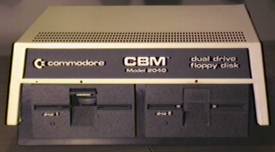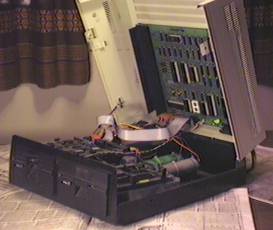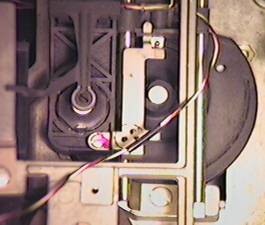 |
 |
 |
 |
 |
 |
 |
This is the CBM 2040 dual drive unit for the PET/CBM line of computers. I think that this was the first disk drive unit that Commodore ever made. It contains two 5¼-inch single-sided drives, with a capacity of 176640 bytes per diskette, and it connects to the PET via the PET's IEEE-488 port. Like other Commodore drive units, it is an intelligent device with its own CPU and RAM. Communicating with the drive is almost like communicating with a modem. |
The Commodore drives pack extra data on a disk by varying the data clock depending on the track number. There are four different "speed zones" on a disk:
| Track Number | Number of Sectors |
|---|---|
| 1 to 17 | 21 |
| 18 to 24 | 20 |
| 25 to 30 | 18 |
| 31 to 35 | 17 |
Tracks are numbered starting from the outside of the disk, so that there is more physical area for data storage on track 1 (outside) than there is on track 35 (inside).
This particular 2040 disk unit has DOS 1.0 built-in, and seems to have been manufactured in 1979.
 |
The 2040 drive shares not only the styling of the PET, but also the hinged top and the support post. Note that only the drive mechanism on the left hand side (Drive 1) has a circuit board on top of it. Drive 0 on the right is exposed, and we can see how the mechanism works (see below). |
The curcuit board that is attached to the top is the 2040's interface and controller. According to Table 3 of the Commodore Dual Floppy Disk Manual, the chief ICs are:
Controller
6504 microprocessor
6530 I/O, RAM, ROM
6522 I/O, interval timers
Interface
6502 microprocessor
6532 (2) I/O, RAM, interval timers
6332 (2) ROM
Shared
6114 (8) 4x1K RAM
The amusing thing about this is that the 2040 apparently has more processing power than the computer it plugs into, and half the memory! No wonder the disk drives were more expensive than the computers.

|
The head positioning mechanism on this beast is interesting. The head is positioned by a spiral-grooved disc. I think this identifies the mechanism as a Shugart drive. These were used in early Apple and Tandy drives as well. I had never been confronted by an exposed one before opening the 2040.
|